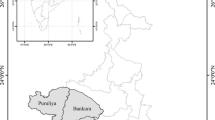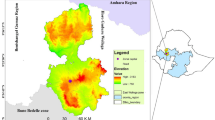Abstract
The study aimed to analyze the probability of occurrence/severity situation of meteorological drought in Peshawar, Pakistan and its impacts on agriculture. Therefore, the past 30-years (1986–2016) meteorological data was collected from Peshawar Meteorological Department and analyzed through Standardized Precipitation Index (SPI) drought software for mild, moderate, severe and extreme droughts on monthly, seasonally and annually basis. Results for the monthly and seasonal analysis found that severe and extreme droughts occurred mostly in May and June in summer, and March and April in spring seasons. The annually basis analysis found severe drought for the years 1989, 2000, 2001 and 2006, in which the most extreme drought year was 2001. Furthermore, the probability of occurrence/percentage of mild drought (12-month) in past 30 years was calculated 34%, moderate 9%, severe 8% and extreme drought 1.6%, These results also provide an insight of drought probability of occurrence and severity in next hundred years. The study concluded that most immediate consequence of drought can be seen in a fall in crop production. No work has been conducted before on measurement of meteorological drought of Peshawar through SPI. Therefore, it is a novel study and will contribute towards preparing for the drought which may affect the crops of Peshawar.


Similar content being viewed by others
REFERENCES
Albert, K., Mikkelsen, T., Michelsen, A., Ro–Poulsen, H., and van der Linden, L., Interactive effects of drought, elevated CO2 and warming on photosynthetic capacity and photosystem performance in temperate heath plants, J. Plant Physiol., vol. 168, no. 13, p. 1550–1561. https://doi.org/10.1016/j.jplph.2011.02.011
Ali, S., Liu, Y., Ishaq, M., Shah, T., Ilyas, A., Din, I.U., Climate change and its impact on the yield of major food crops: Evidence from Pakistan, Foods, 2017, vol. 6, no. 6, p. 39. https://doi.org/10.3390/foods6060039
Asrari, E. and Masoudi, M., A new methodology for drought vulnerability assessment using SPI (Standardized Precipitation Index), Int. J. Sci. Res. Knowl., 2014, vol. 2, no. 9, p. 425. https://doi.org/10.12983/ijsrk-2014-p0425-0432
Bukhari, S. and Bajwa, G., Development of National Response Strategy to Combat Impacts of Climate Change on Forest of Pakistan, Pakistan Forest Inistitute Peshawar, 2012.
Chaudhry, Q., Sheikh, M., Bari, A., and Hayat, A., History’s Worst Drought Conditions Prevailed over Pakistan, 2001.
Cook, E. R., Seager, R., Cane, M.A., and Stahle, D.W., North American drought: Reconstructions, causes, and consequences, Earth Sci. Rev., 2007, vol. 81, nos. 1–2, pp. 93–134. https://doi.org/10.1016/j.earscirev.2006.12.002
Crops Area and Production (By Districts) (1981–82 TO 2008–09), Government of Pakistan, 2011.
Crop Statistics, Khyber Pakhtunkhwa, in L.C.D. Agriculture (Editor), Government of Khyber Pakhtunkhwa, 2013.
Dai, A., Increasing drought under global warming in observations and models, Nat. Clim. Change, 2013, vol. 3, no. 1, p. 52. https://doi.org/10.1038/nclimate1633
Drought Basics RMC Peshawar, Monthly Climate Normal’s of Pakistan, Regional Meteorological Centre Peshawar, 2011.
Drought Facts, Ojos Negros Research Group, 2019.
Fahim, A.M., Shen, R., Ali, S.M., and Zhang, J., Characteristics of drought variation in winter using drought indices during the period 1971–2010: A case study of Khyber Pakhtunkhwa (Pakistan), Mausam, 2016, vol. 67, no. 3, pp. 697–708.
Flannigan, M. and Harrington, J.B., A study of the relation of meteorological variables to monthly provincial area burned by wildfire in Canada (1953–80), J. Appl. Meteorol., 1988, vol. 27, no. 4, pp. 441–452. https://doi.org/10.7939/R3Q814V7R
Fuchs B, National Drought Mitigation Center. US Drought Monitor, 2019.
Government of Khyber Pakhtunkhwa, Peshawar, 2018.
Haldar, I., Global Warming: the Causes and Consequences, Mind Melodies, ASBN:13, 2010, p. 987-93-80302-81-2.
Herweijer, C., Seager, R., Cook, E.R., and Emile–Geay, J., North American droughts of the last millennium from a gridded network of tree–ring data, J. Clim., 2007, vol. 20, no. 7, pp. 1353–1376. https://doi.org/10.1175/JCLI4042.1
Iqbal, M., Raja, N., Yasmeen, F., Hussain, M., Ejaz, M., and Shah, M., Impacts of heat stress on wheat: A critical review, Adv. Crop Sci. Technol., 2017, no. 5, pp. 1–9. https://doi.org/10.4172/2329-8863.1000251
Iqbal, M.M., Goheer, M.A., Noor, S., Sultana, H., Salik, K., and Khan, A., Climate Change and Agriculture in Pakistan: Adaptation Strategies to Cope with Negative Impacts. Research Report GCISC–RR–16, Global Change Impact Studies Centre, Islamabad, 2009.
Jain, V.K., Pandey, R.P., Jain, M.K., and Byun, H.R., 2015. Comparison of drought indices for appraisal of drought characteristics in the Ken River Basin, Weather and Climate Extremes, 2015, no. 8, pp. 1–11. https://doi.org/10.1016/j.wace.2015.05.002
Kiem, A.S. and Franks, S.W., Multi–decadal variability of drought risk, eastern Australia, Hydrol. Processes, 2004, vol. 18, no. 11, pp. 2039–2050. https://doi.org/10.1002/hyp.1460
Larsen, O., Oliver, J., and Casiles Lanuza, E., Developing a Disaster Risk Insurance Framework for Vulnerable Communities in Pakistan: Pakistan Disaster Risk Profile. Report no. 16, Bonn: United Nations University Institute for Environment and Human Security (UNU-EHS), 2014.
Lasage, R., Aerts, J., Mutiso, G.C., and De Vries, A., Potential for community based adaptation to droughts: Sand dams in Kitui, Kenya, Phys. Chem. Earth, Parts A/B/C, 2008, vol. 33, nos. 1–2, pp. 67–73. https://doi.org/10.1016/j.pce.2007.04.009
Mckee, T.B., Doesken, N.J., and Kleist, J., The relationship of drought frequency and duration to time scales, in Proceedings of the 8th Conference on Applied Climatology, American Meteorological Society, Boston, 1993, pp. 179–183.
Mendelsohn, R., Global Warming and the American Economy, Edward Elgar Publishing, 2001. https://doi.org/10.5772/25204
Méndez, M., and Magaña, V., Regional aspects of prolonged meteorological droughts over Mexico and Central America, J. Clim., 2010, vol. 23, no. 5, pp. 1175–1188. https://doi.org/10.1175/2009JCLI3080.1
Metz, B., Davidson, O., Swart, R., and Pan, J., Climate change 2001: Mitigation: Contribution of Working Group III to the third assessment report of the Intergovernmental Panel on Climate Change, Cambridge University Press, 2001.
Mishra, V. and Cherkauer, K.A., Retrospective droughts in the crop growing season: Implications to corn and soybean yield in the Midwestern United States, Agric. For. Meteorol., 2010, vol. 150, no. 7–8, p. 1030–1045. https://doi.org/10.1016/j.agrformet.2010.04.002
National Disaster Management Plan, National Disaster Management Authority of Pakistan, Islamabad, 2012.
Nebraska–Lincoln, N., Types of droughts, in N.D.M. Centre (Editor), University of Nebraska–Lincoln, 2017.
Nelson, G.C., Rosegrant, M.W., Koo, J., Robertson, R., Sulser, T., Zhu, T., Ringler, C., Msangi, S., Palazzo, A., and Batka, M., Climate Change: Impact on Agriculture and Costs of Adaptation, Int. Food Policy Research Inst., 2009.
NOAA, National Oceanic and Atmospheric Administration’s. Definition of Drought, 2019.
Olesen, J.E. and Bindi, M., Consequences of climate change for European agricultural productivity, land use and policy, Eur. J. Agron., 2002, vol. 16, no. 4, pp. 239–262. https://doi.org/10.1016/s1161-0301(02)00004-7
Orville, H.D., AMS statement on meteorological drought, Bull. Am. Meteorol. Soc., 1990, vol. 71, no. 7, pp. 1021–1025. https://doi.org/10.1175/1520-0477-71.7.1021
Palmer, W.C., Meteorological Drought, US Department of Commerce, Weather Bureau, 1965, vol. 30.
Parry, M., Parry, M.L., Canziani, O., Palutikof, J., van der Linden, P., and Hanson, C., Climate change 2007–impacts, adaptation and vulnerability: Working group II contribution to the fourth assessment report of the IPCC, Cambridge University Press, 2007.
Pausas, J.G., Changes in fire and climate in the eastern Iberian Peninsula (Mediterranean basin), Clim. Change, 2004, vol. 63, no. 3, pp. 337–350. https://doi.org/10.1023/b:clim.0000018508.94901.9c
Pei, F., Li, X., Liu, X., and Lao, C., Assessing the impacts of droughts on net primary productivity in China, J. Environ. Manage., 2013, no. 114, pp. 362–371. https://doi.org/10.1016/j.jenvman.2012.10.031
PWP, History of drought in Pakistan – In detail. Pakistan Weather Portal, 2011.
Qureshi, A.S. and Akhtar, M., Analysis of Drought–Coping Strategies in Baluchistan and Sindh Provinces of Pakistan, IWMI, 2004, no. 86.
Seager, R., Ting, M., Davis, M., Cane, M., Naik, N., Nakamura, J., Li, C., Cook, E., and Stahle, D., Mexican drought: an observational modeling and tree ring study of variability and climate change, Atmosfera, 2009, vol. 22, no. 1, pp. 1–31.
Shanahan, T.M., Overpeck, J.T., Anchukaitis, K., Beck, J.W., Cole, J.E., Dettman, D.L., Peck, J.A., Scholz, C.A., and King, J.W., Atlantic forcing of persistent drought in West Africa, Science, 2009, vol. 324, no. 5925, pp. 377–380. https://doi.org/10.1126/science.1166352
Szarzynski, J., Zhang, W., and Tatem, B., Climate Change and Drought in California, 2014. https://digitalcommons.pepperdine.edu/sturesearch.
Standardized Precipitation Index User Guide, (WMO-No. 1090), World Meteorological Organization, Genewa, 2012.
Tigkas, D., Vangelis, H., and Tsakiris, G., Drought and climatic change impact on streamflow in small watersheds, Sci. Total Environ., 2012, no. 440, pp. 33–41. https://doi.org/10.1016/j.scitotenv.2012.08.035
Ullah, W. and Takaaki, N., Climate Change Vulnerability of Pakistan Towards Natural Disasters: A Review, International Journal of Environmental Protection and Policy, 2016, vol. 4, no.5, pp. 1–7. https://doi.org/10.11648/j.ijepp.20160405.13
Wang, L., Chen, W., Zhou, W., and Huang, G., Understanding and detecting super–extreme droughts in Southwest China through an integrated approach and index, Q. J. R. Meteorol. Soc., 2016, vol. 142, no. 694, p. 529–535. https://doi.org/10.1002/qj.2593
Wilhite, D.A., Drought as a natural hazard: concepts and definitions, Drought: A Global Assessment, 2000, vol. 1, no. 1, pp. 3–18.
Wilhite, D.A., Drought Management, Water Encyclopedia, 2019. http://www.waterencyclopedia.com/Da-En/Drought-Management.html
Zhai, J., Su, B., Krysanova, V., Vetter, T., Gao, C., Jiang, T., Spatial variation and trends in PDSI and SPI indices and their relation to streamflow in 10 large regions of China, J. Clim, 2010, vol. 23, no. 3, p. 649–663. https://doi.org/10.1175/2009jcli2968.1
ACKNOWLEDGMENTS
We are highly thankful to Meteorological Department-Peshawar for providing data and technical support.
Author information
Authors and Affiliations
Corresponding author
Ethics declarations
Conflict of interests. The authors declare that they have no conflicts of interest.
Statement on the welfare of animals. This article does not contain any studies involving animals performed by any of the authors.
Rights and permissions
About this article
Cite this article
Nazneen, S., Ayaz, T., Durrani, Y. et al. Meteorological Drought Measurement with Deficit in Rainfall Occurrence According to SPI Indices: a case Study of Peshawar, Pakistan. Arid Ecosyst 13, 20–28 (2023). https://doi.org/10.1134/S2079096123010109
Received:
Revised:
Accepted:
Published:
Issue Date:
DOI: https://doi.org/10.1134/S2079096123010109




